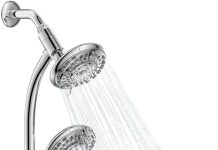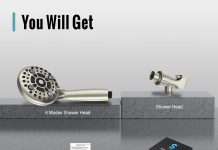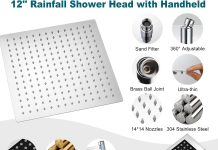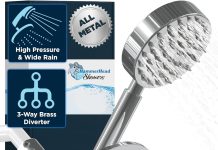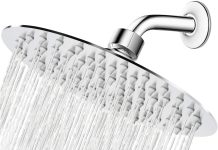Step into the world of luxurious showers with rainfall shower heads. These captivating bathroom fixtures are designed to mimic the experience of standing under a gentle rain shower. But have you ever wondered how they work?
In this article, we will examine the mechanics behind rainfall showerheads and discover the secrets that make them so refreshing and relaxing. Get ready to indulge in a showering experience like no other!
Table of Contents
Understanding Rainfall Shower Heads
What is a rainfall showerhead?
A rainfall shower head is a type of shower fixture designed to mimic the experience of standing in the rain. It is more significant than traditional shower heads and typically has a wide, flat design that allows for a gentle and even water distribution over a large area. Rainfall shower heads are mounted directly above the user’s head, creating a luxurious and immersive showering experience.
Advantages of using a rainfall shower head
Using a rainfall shower head offers several advantages compared to traditional shower heads. Firstly, the comprehensive water coverage provides a more relaxing and spa-like experience. The gentle rainfall-like flow helps to wash away stress and tension, creating a calming effect. Additionally, the large shower head makes rinse and thoroughly cleanse the body easier.
Another advantage of rainfall shower heads is that they can be adjusted to provide different water flow settings. This allows users to customize their shower experience based on their preferences. Whether one prefers a drizzle or a heavier downpour, rainfall shower heads offer flexibility in water pressure and flow patterns.
Types of rainfall shower heads
There are various types of rainfall shower heads available on the market. The most common types include:
- Ceiling-mounted rainfall shower heads: These are installed directly into the ceiling, providing a seamless and minimalist appearance. This type of installation is ideal for bathrooms with a modern or contemporary design.
- Wall-mounted rainfall shower heads: These are mounted on the wall at a height that suits the user’s preference. They are adjustable and allow for flexibility in positioning. This type of installation is suitable for bathrooms with limited ceiling height or for those who prefer a more traditional look.
- Handheld rainfall shower heads: These are attached to a flexible hose, allowing for easy maneuverability and targeted water flow. They can be handheld or mounted on a bracket, offering the convenience of traditional shower heads with the luxurious feel of rainfall shower heads.
Operation of Rainfall Shower Heads
Water flow mechanisms
Rainfall shower heads use more extensive water flow mechanisms than traditional shower heads. They have wider channels and larger orifices, allowing a higher water volume to pass through. This creates the gentle and wide-spread flow that simulates rainfall.
A diverter or built-in mixing valve generally controls the water flow in a rainfall shower head. The diverter valve redirects the water from the existing plumbing system to the shower head while the mixing valve adjusts the water temperature.
Nozzles and spray patterns
Rainfall shower heads are equipped with a significant number of nozzles that are strategically placed across the surface of the shower head. These nozzles are responsible for dispersing the water evenly and creating the desired spray pattern.
The spray pattern can vary from shower head to head, with options such as rainfall, mist, and jet streams. Some advanced models even offer customizable spray patterns to suit individual preferences. The number and arrangement of the nozzles also contribute to the overall water flow and coverage.
Water pressure and flow rate
A rainfall shower head’s water pressure and flow rate are essential for a satisfactory shower experience. While rainfall shower heads generally require a higher water pressure to function optimally, ensuring that the existing plumbing system can provide adequate water flow is essential.
Water pressure can be regulated through pressure valves or regulators, ensuring the flow remains consistent and comfortable. However, it is worth noting that water pressure and flow rate may vary depending on the specific rainfall shower head model and the water supply in the area.
Installation and Maintenance
Installing a rainfall showerhead
Installing a rainfall shower head can be straightforward with the right tools and instructions. Before beginning the installation, ensuring the existing plumbing system is compatible with the chosen shower head is essential. Also, hiring a professional plumber for complex installations or when dealing with specific plumbing requirements may be necessary.
To install a rainfall shower head, follow these general steps:
- Turn off the water supply to the shower.
- Remove the existing shower head using a wrench.
- Clean the shower arm and check for any blockages.
- Apply the plumber’s tape to the threads of the shower arm to create a watertight seal.
- Screw the rainfall shower head onto the shower arm and hand-tighten it.
- Use a wrench to ensure the shower head is securely fastened, taking care not to overtighten and damage the fixture.
- Turn on the water supply and check for any leaks or drips.
- Adjust the flow and settings of the shower head to your preference.
Maintenance and cleaning
Regular maintenance and cleaning are essential to ensure the longevity and efficient performance of a rainfall shower head. Here are some tips to keep in mind:
- Clean the shower head regularly to remove any mineral or sediment buildup. This can be done by soaking the shower head in vinegar and water and gently scrubbing it with a soft brush.
- Check the nozzles for any clogs or blockages. Use a toothpick or small brush to remove debris obstructing the water flow.
- Inspect the shower head for any signs of wear and tear, such as leaks or loose parts. Replace any damaged or faulty components promptly.
- Avoid using abrasive cleaners or harsh chemicals that may damage the shower head’s finish. Stick to mild soap and water for routine cleaning.
Preventing clogs and blockages
It is important to take certain precautions to prevent clogs and blockages in your rainfall shower head. Here are some tips to keep in mind:
- Install a water filter or softener in your plumbing system to reduce the concentration of minerals and sediment in the water. This can help prevent buildup in the shower head and prolong its lifespan.
- Use a shower head with self-cleaning nozzles or a silicone spray face. These features are designed to resist mineral buildup and make cleaning easier.
- Regularly remove and clean the shower head, as mentioned earlier. Doing so can prevent sediment and debris from accumulating and causing blockages.
- Avoid using shampoos or soaps directly under the shower head, as the residues can contribute to clogging. Rinse off any products thoroughly to ensure they do not accumulate in the shower head.
Choosing the Right Rainfall Shower Head
Considerations before buying
When choosing a rainfall shower head, there are several factors to consider. These include:
- Water pressure: Ensure that the chosen shower head is compatible with the existing water pressure in your home. Some models require higher water pressure to function optimally, while others are designed to work well even with lower pressure.
- Size of the shower head: Consider the size of the rainfall shower head and whether it fits the available space in your shower. Larger shower heads provide a more immersive rainfall experience but may not be suitable for smaller bathrooms.
- Material and finish: Look for a showerhead from durable stainless steel or brass materials. Consider the shower head’s finish, whether it matches the existing bathroom fixtures, and whether it is resistant to tarnishing or corrosion.
- Budget: Determine your budget for the rainfall shower head. Prices can vary depending on the brand, features, and materials used. Consider your requirements and choose a showerhead that offers a good balance between quality and affordability.
Size and design options
Rainfall shower heads are available in various sizes and designs to suit different preferences and bathroom styles. The shower head’s size determines the water coverage and the rainfall experience’s intensity.
More minor, typically around 6-8 inches in diameter, shower heads provide a gentle and focused rainfall feel. They suit bathrooms with limited space or prefer a more subtle rainfall effect.
Larger shower heads, ranging from 10-16 inches in diameter, offer a more immersive and luxurious experience. They provide a more comprehensive water coverage and create an actual rainfall effect. However, larger shower heads require more water pressure to function optimally and may not be suitable for all bathrooms.
Design options for rainfall shower heads are extensive, ranging from sleek and modern styles to more traditional and ornate designs. Consider the overall aesthetic of your bathroom and choose a showerhead that compliments the existing decor.
Additional features to look for
When selecting a rainfall shower head, additional features can enhance the overall shower experience. These include:
- Adjustable settings: Look for a shower head with adjustable settings such as water pressure, flow rate, and spray pattern. This allows for customization based on personal preferences and mood.
- Built-in LED lights: Some rainfall shower heads have built-in LED lights, creating a soothing and atmospheric ambiance. The lights can change color or be set to a specific tone, adding a touch of luxury to the shower experience.
- Water-saving features: Consider shower heads incorporating technologies such as aerators or flow restrictors. These features help reduce water consumption while still providing a satisfactory rainfall effect.
- Easy installation and maintenance: Choose a rainfall shower head that is user-friendly in terms of installation and maintenance. Look for features such as tool-free installation, easy-clean nozzles, and replaceable parts.
Water Conservation with Rainfall Shower Heads
Water-saving technologies
Rainfall shower heads have evolved to incorporate water-saving technologies without compromising the luxurious showering experience. Some of the critical water-saving features to look for include:
- Aerators are small devices that mix air with the water stream, reducing the overall water flow while maintaining adequate pressure. Aerators help conserve water by limiting the amount of water used per minute.
- Flow restrictors: These devices reduce the water flow rate by restricting water flow through the shower head. They typically have adjustable settings, allowing users to control the desired flow.
- Timer systems: Some advanced rainfall shower heads have built-in timers that alert users when they have been showering for a predetermined time. This encourages more mindful water usage and helps to reduce overall consumption.
By incorporating these water-saving technologies, rainfall shower heads can offer a luxurious shower experience while helping to conserve water and promote environmental sustainability.
Regulating water temperature
Maintaining the desired water temperature is essential for an enjoyable shower experience. Rainfall shower heads can be equipped with thermostatic or pressure-balancing valves to regulate and stabilize water temperature.
Thermostatic valves allow users to set and maintain a specific water temperature, ensuring a consistent and comfortable shower experience. These valves can help prevent sudden temperature fluctuations when other water sources in the house are used simultaneously.
Pressure-balancing valves maintain a steady water temperature in response to changes in water pressure. They ensure that the temperature remains constant even when there are variations in the hot and cold water supply.
Usage tips for saving water
While rainfall shower heads may offer a luxurious bathing experience, it is essential to be mindful of water consumption. Here are some usage tips for saving water:
- Keep showers to a reasonable duration. Aim for shorter showers and avoid unnecessary lingering under the rainfall shower head.
- Use the shower head’s lowest comfortable water pressure and flow rate settings. This helps to reduce water usage while still enjoying the rain-like experience.
- Consider using a shower timer or setting a personal timer to keep track of your shower duration. This can help encourage more water-conscious habits and prevent excessive water consumption.
- Look out for leaks or drips from the shower head and promptly address them. Fixing leaks can significantly reduce water wastage and lower utility bills.
Upgrade Your Shower Experience
Enhancing relaxation and comfort
One of the primary reasons to upgrade to a rainfall shower head is to enhance relaxation and comfort. The soft, gentle flow of water creates a soothing sensation, helping to relieve stress and tension.
The comprehensive coverage of the shower head ensures that the entire body is enveloped in a warm cascade of water, providing a more immersive shower experience. The rainfall stimulates the senses and promotes a sense of tranquility, making it ideal for unwinding after a long day.
Creating a spa-like atmosphere
Installing a rainfall shower head can transform an ordinary shower into a luxurious spa-like experience. The gentle and enveloping flow of water, coupled with the comprehensive coverage, creates a pampering sensation reminiscent of a high-end spa.
Add features such as aromatherapy essential oil diffusers, chromotherapy lighting, or even Bluetooth speakers for music to enhance the spa-like atmosphere. These details can create a truly indulgent and personalized shower experience in the comfort of your own home.
Improving overall bathroom aesthetics
In addition to the relaxation and comfort benefits, rainfall shower heads can also improve the overall aesthetics of your bathroom. The sleek and modern design of many rainfall shower heads adds a touch of elegance and sophistication to the space.
Rainfall shower heads can be a focal point in the bathroom, drawing attention and adding visual interest. Their larger size and unique shape create a statement piece that elevates the bathroom’s overall design, making it more inviting and visually appealing.
Comparing Rainfall Shower Heads with Traditional Shower Heads
Advantages of rainfall shower heads
Rainfall shower heads offer several advantages over traditional shower heads. These advantages include:
- Luxurious shower experience: Rainfall shower heads provide a more immersive and luxurious shower experience than traditional ones. The comprehensive coverage and gentle water flow create a calming and spa-like effect.
- Even water distribution: The larger size and design of rainfall shower heads ensure that water is distributed evenly over a wider area. This allows for more efficient rinsing and cleansing of the body.
- Customizable settings: Many rainfall shower heads offer adjustable settings such as water pressure, flow rate, and spray patterns. This allows users to customize their shower experience based on personal preferences.
- Aesthetically pleasing: The sleek and modern design of rainfall shower heads adds visual interest and sophistication to the bathroom. They can serve as focal points and enhance the overall aesthetics of the space.
Disadvantages of rainfall shower heads
While rainfall shower heads offer numerous benefits, there are also some potential disadvantages to consider:
- Higher water consumption: Rainfall shower heads typically require a higher water pressure to function optimally. This can result in higher water consumption compared to traditional shower heads. However, water-saving features can help mitigate this issue.
- Limited space requirement: Rainfall shower heads are generally larger and require more vertical space than traditional shower heads. This may pose a challenge for bathrooms with low ceilings or limited space.
- Installation complexity: Depending on the specific model and plumbing system, installing a rainfall shower head may require more expertise and potentially professional assistance. Complex installations may incur additional costs.
- Cost: Rainfall shower heads can be more expensive than traditional ones due to their larger size, design, and additional features. Considering one’s budget and weighing the cost against the desired benefits is essential.
Comparison of features and benefits
Here is a comparison of some of the key features and benefits of rainfall shower heads and traditional shower heads:
| Features | Rainfall Shower Heads | Traditional Shower Heads |
|---|---|---|
| Shower Experience | Luxurious and spa-like | Standard and practical |
| Water Distribution | Even wide coverage | Concentrated flow |
| Customization | Adjustable settings for pressure, flow rate, and spray patterns | Limited customization options |
| Aesthetics | Modern and visually appealing | Can vary based on design and finish |
| Water Consumption | It can be higher, but water-saving features are available | Typically, lower water consumption |
| Installation | May require professional assistance for complex installations | Generally straightforward and user-friendly |
| Cost | It can be more expensive | Often more affordable |
Frequently Asked Questions (FAQs)
What is the ideal height for installing a rainfall shower head?
The ideal height for installing a rainfall shower head can vary depending on personal preference and the specific design of the shower head. However, a standard recommendation is to mount the shower head at 7-8 feet (2.1-2.4 meters) from the floor. This allows for sufficient clearance and ensures the water is evenly distributed over the body.
How does a rainfall showerhead simulate natural rainfall?
A rainfall shower head simulates natural rainfall through its design and water flow. The vast shower head’s wide and flat surface and many strategically placed nozzles create a gentle and even water flow. This mimics the soothing effect of standing in the rain, providing a relaxing and immersive shower experience.
Can rainfall shower heads be installed in any bathroom?
Rainfall shower heads can be installed in most bathrooms; however, certain factors must be considered. The availability of sufficient ceiling or vertical space is essential, as rainfall shower heads are more prominent and require more room than traditional shower heads.
The existing plumbing system should also be compatible with the desired rainfall shower head. It is advisable to consult a professional plumber to assess the feasibility of installation and ensure that the water pressure is suitable for the chosen shower head.
Conclusion
In conclusion, rainfall shower heads offer a luxurious and immersive shower experience that can enhance relaxation, comfort, and overall bathroom aesthetics. With their comprehensive coverage and gentle flow of water, rainfall shower heads simulate the sensation of standing in the rain, providing a calming effect and promoting a spa-like atmosphere.
When choosing a rainfall shower head, it is essential to consider factors such as water pressure, size, design, and additional features. Regular maintenance and cleaning are essential to ensure optimal performance and longevity. Water-saving technologies incorporated into rainfall shower heads can help promote water conservation and environmental sustainability.
While there are several advantages to rainfall shower heads, it is important to weigh them against potential disadvantages such as higher water consumption, installation complexities, and cost.
By understanding the functioning, installation, and maintenance of rainfall shower heads, one can make an informed decision and upgrade their shower experience to a new level of relaxation and luxury.


